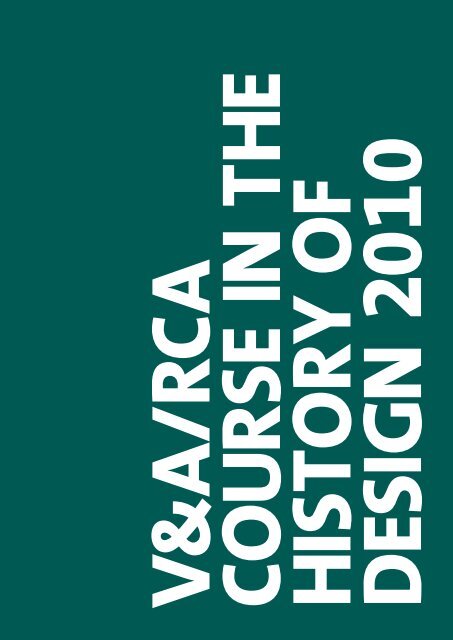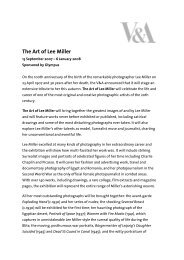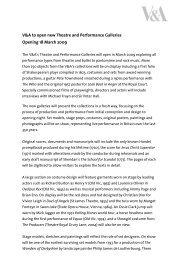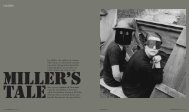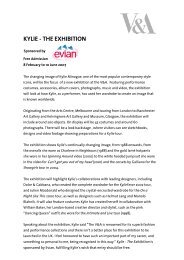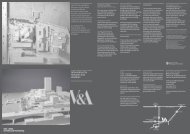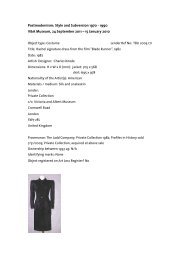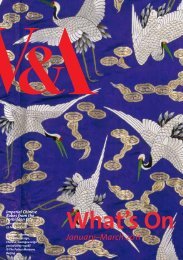jAnE PAVitt - Victoria and Albert Museum
jAnE PAVitt - Victoria and Albert Museum
jAnE PAVitt - Victoria and Albert Museum
You also want an ePaper? Increase the reach of your titles
YUMPU automatically turns print PDFs into web optimized ePapers that Google loves.
V&A/RCACOURSE in thehistory ofdesign 2010
STATEMENT BYHEADS OF COURSEThe V&A/RCA History of Design <strong>and</strong> MaterialCulture Course Bulletin is a welcome opportunity totake stock of recent achievements <strong>and</strong> focus on thechallenges ahead. 2010 has been an excellent yearfor the Programme, now entering its 27th year ofexistence. We have seen the graduation of anotherstrong cohort of MA, MPhil <strong>and</strong> PhD students. Whatunites them is a dedicated approach to originalsources, while exploiting a variety of disciplinaryapproaches <strong>and</strong> methodologies – from archaeologyto business history. Their research has spanned theperiod 1400 to the present day <strong>and</strong> the widerangingchoice of subject – from the design of earlymodern city walls, Suffragettes’ dress <strong>and</strong> offshoreoil platforms – is a testimony to the breadth ofresearch interests fostered by the Programme.This year has been marked by the graduation of thefirst group of Asian Design History specialists,under the leadership of Dr Christine Guth. Theirdissertations range from a study of the visual <strong>and</strong>material identity of the London-based Chinesecommunity of Limehouse in the early 20th century,to the representation of Indian contemporaryjewellery in Vogue India. We cherish their contributionin exp<strong>and</strong>ing enormously the geographical <strong>and</strong>intellectual breadth of the Programme. As ever wewish all recent graduates the best in their present<strong>and</strong> future endeavours.Some interesting patterns emerge from the list ofthis year’s MA <strong>and</strong> PhD dissertation subjects. Astrong research core focuses on the interconnectionsbetween design, consumption <strong>and</strong> space, whetherwithin the domestic chapels of Late-MedievalEngl<strong>and</strong>, the opera <strong>and</strong> exhibition venues ofSecessionist Vienna or the digital museum. A shifttoward production-led enquiry is another significanttrend, fixing early modern artisanal practice inLondon, or the organization of labour in a Norwichbasedtextile company in the first half of thetwentieth century.First-year Renaissance, Modern <strong>and</strong> Asian DesignHistory students are also very significant contributorsto the success of the Programme. The summariesof some of the first term essays included in thisbulletin – examining for instance a Limoges casket,a seventeenth-century English ‘adorned’ print <strong>and</strong> aMing porcelain pillow – show the depth, originality<strong>and</strong> ambition of their work. Drawing from a widerange of primary <strong>and</strong> secondary sources <strong>and</strong>applying meticulous object-analysis skills, theseessays demonstrate exhilarating intellectualcuriosity <strong>and</strong> critical rigour. Their contribution thisyear has extended into the <strong>Museum</strong>’s largestgallery projects, where students have been involvedin the refurbishment <strong>and</strong> installation of the V&A’sCeramics Galleries Phase II, which opened in thesummer to public acclaim.Research has also been at the centre of the Course 02/03Team’s activities over the past year, oftenundertaken within the context of broaderpartnerships with other prestigious academic <strong>and</strong>research institutions, from the universities ofWarwick, London <strong>and</strong> Cambridge to the WellcomeTrust, as the following pages testify. A numberof projects result from the close collaborationbetween different members of the team – fromthe forthcoming Postmodernism exhibition to theGlobal Design History volume, from the Surfacetensions to the Intoxicants <strong>and</strong> Intoxication researchnetworks <strong>and</strong> the V&A/IHR Early Modern MaterialCultures research seminar programme.There have been several exciting <strong>and</strong> momentouschanges to report in the Course staff team. Wewelcome Dr. <strong>Victoria</strong> Kelley <strong>and</strong> Dr. RichardChecketts who have joined the Course as Tutors atthe RCA <strong>and</strong> the V&A respectively. Dr. GlennAdamson continues his secondment as co-curatoron the major V&A Postmodernism exhibition, whileDr. Marta Ajmar-Wollheim continues as ActingHead of Graduate Studies at the V&A. DavidCrowley has been appointed RCA Professor, <strong>and</strong>Head of a new MA in Critical Writing in Art <strong>and</strong>Design at the college. Finally, Jane Pavitt has joinedthe RCA as the new Head of the History of DesignDepartment. We look forward to working togetherwith everyone in these new capacities in thecoming years.We are delighted that so many our former studentshave gone on to greater things <strong>and</strong> hope thatthey will continue to keep a close connection withthe Programme.Marta Ajmar-WollheimActing Head of Graduate Studies, V&Am.ajmar@vam.ac.ukJane PavittHead of History of Design, RCAjane.pavitt@rca.ac.uk
student essayA Ming Dynasty Ceramic PillowKirstin Beattie (ASIAN SPECIALISM)There are many examples of Chinese ceramicpillows that survive in museums worldwide today.Despite this, relatively little is known about theirfunction within this society since their firstmanufacture in the Tang Dynasty (618–907). Thisessay analyses the use <strong>and</strong> value of ceramic pillowswithin the Ming Dynasty (1368–1644), in relation toa pillow held in the V&A collection (hereafter the“V&A pillow”). It is of fahua-type ware, dated tobetween 1450 <strong>and</strong> 1550, <strong>and</strong> is in the form of awoman reclining. This pillow was probably found inthe grave, but was not solely made for this context,<strong>and</strong> was first used in life. As an object used duringsleep, the pillow’s mere functionality associates itwith the bedroom. It is for this reason that I willassess the space of the bedroom within thedomestic sphere, in order to determine what kindof meanings the pillow may have had as an objectplaced <strong>and</strong> used in this room. The female form <strong>and</strong>symbolism of the object will be analysed to furtherlink it to this space, <strong>and</strong> in order to generate anargument that the V&A pillow would have beenviewed as an object related to feminine concerns.The V&A pillow was bought by the <strong>Museum</strong> in 1911from dealers S. M. Franck & Co., an importer ofgoods from the Near <strong>and</strong> Far East. The acquisitionfile states that due to the building of railway linesin China in the early years of the century, hugequantities of objects such as this were being dugup from the ground, mostly from graves. 1 It seemslikely that this was the circumstance in whichthe V&A pillow was found. Fahua-type warewas usually made for utilitarian purposes, <strong>and</strong> isdistinguished by its palette of amber, deep purple<strong>and</strong> blue. It was produced extensively in theNorthern province of Shanxi between thefourteenth <strong>and</strong> sixteenth centuries. 2 The pillow hasbeen shaped into a woman reclining on arectangular base, above which is a concavemarbled platform. She wears a headdress, necklace,bracelets <strong>and</strong> earrings, <strong>and</strong> rests her own head on aminiature cylindrical pillow. This human form isrelatively rare: the vast majority of pillows are a boxshape made up of flat surfaces on which thedecoration is painted. 3 The pillow is also unusual asa modelled form that indicates what one should dowith the object itself: lie or sleep on it.Pillows were a common type of grave object. 4Wealthy Chinese buried their dead with all theobjects <strong>and</strong> food that they would need for comfortin the afterlife. Together with items such as textiles<strong>and</strong> crockery that were used while the person wasalive, pillows were interred underground as part ofthe evidence of the deceased’s daily life. 5 Whileused by the living, the pillow belonged to thebedroom, <strong>and</strong> formed part of the furnishings of thebed. Sometimes exquisitely beautiful <strong>and</strong> highlycrafted objects, ceramic pillows were clearlyrelatively luxurious items, <strong>and</strong> as such only wealthyfamilies would have owned <strong>and</strong> used them. This isemphasised on the V&A pillow itself by therepresentation of wealth: the jewellery, fan <strong>and</strong>dog are clear status symbols.The domestic sphere in early modern China was agender-divided space: Ming illustration <strong>and</strong>literature regularly represents the bedroom as thelocus of the female apartment <strong>and</strong> of femininityitself. 6 Historian Sarah H<strong>and</strong>ler states that ‘just asthe desk was the focal point of a man’s studio, thebed was at the centre of a woman’s bedroom’. 7The bed was the symbolic <strong>and</strong> actual location ofprocreation, of the woman’s principle role ofproviding male heirs for the ancestral line. Inwealthy families it formed part of a bride’s dowryalong with other objects associated with thebedroom such as bedcovers <strong>and</strong> curtains, otherfurniture, clothes <strong>and</strong> make-up. As an integral partof the furnishings of a bedroom, it seems possiblethat a pillow could be part of the dowry. It mayalso, therefore, be an object that was regarded asgendered, as something which belonged in awoman’s room, <strong>and</strong> that was perhaps owned by awoman.Objects found in the bedroom were oftengenerously ornamented with auspicious symbolsrelating to sexuality <strong>and</strong> procreation. Commonmotifs such as peony, plum blossom <strong>and</strong> peachwere associated with fertility, <strong>and</strong> that of the“Hundred Boys” referred to the common wish formany sons. 8 Domestic marital themes such as thiswould be entirely appropriate to the bedroom, <strong>and</strong>especially to the bed. It is not unreasonable,therefore, to interpret the lying female figure onthe V&A pillow as having a procreative messageitself, <strong>and</strong> to suggest that it would have had arelationship to the other objects around it throughthis symbolism. Certainly few objects would bemore suitable in location for this type of message,which is not unfamiliar in pillows; others displayromantic poetry, marriage scenes <strong>and</strong> young malechildren. 9It is clear that the pillow <strong>and</strong> its representation of awoman lying down would have been readilyinstalled within the discourses relating todomesticity <strong>and</strong> procreation, concurrently with theother objects found in the female quarter.Literature can be used finally to corroborate this.The following is an extract from Meiren fu (“On aBeautiful Woman”) by Sima Xiangru (d.117 B.C.):‘A lovely girl alone in her room, reclining on a bed, astrange flower of unsurpassed elegance, of gentlenature but of luscious appearance…Then she madethe bedstead ready, provided with the rarestluxuries, including a bronze censer for scenting thequilts…The mattresses <strong>and</strong> coverlets were piled up,the pointed pillows lay across them’. 10The pillow clearly formed an integral part of theimagined interiority of a woman’s space. She <strong>and</strong> itwere both objects within the rhetoric of romanceperpetuated by stories <strong>and</strong> illustration in the MingDynasty. Even if used by a man in the bedroom, theV&A pillow was more closely associated with thefemale by virtue of its form <strong>and</strong> placement.04/05
A Limoges Painted Enamel Casket byJean Limousin, c.1620RACHAEL BRADFORD (renaissance specialism)Monograms are generally interpreted today asmarks of authorship or ownership. A Limogespainted enamel casket, dated around 1620, inthe V&A collections, potentially exhibits bothfunctions. It is monogrammed with the initials ofits maker, Jean Limousin, but also has a rear plaquedevoted entirely to the cipher of Queen Anneof Austria (1601–1666). Indeed, on acquisitionthe casket was believed to have potential royalprovenance, <strong>and</strong> has since been viewed as aprincely treasure by the museum.Through a close investigation of the Limousincasket, this essay attempts to interrogate issues ofownership, <strong>and</strong> expose the potential hazards of‘reading’ monogrammed historical artefacts. Itexplores the function of emblazoned objects <strong>and</strong>reveals that, rather than a simple royal trinket box,the Limousin casket potentially embodies thechanging relations between monarch,manufacturer <strong>and</strong> loyal subject in seventeenthcentury France.Enameling is the ancient art of fusing glass onto ametal plate at high temperature. 1 In the fifteenthcentury, goldsmiths in Limoges perfected thetechnique of ‘painted’ enamels to create enigmaticpictorial effects. Protected by royal edict, theenamellers guarded their techniques within aculture of secrecy <strong>and</strong> by the sixteenth century,painted enamels had become precious ‘objets devertu’, commissioned by royalty <strong>and</strong> oftenemblazoned with coats of arms. 2Iconographic analysis of the casket points to noble,female ownership. Composed of nine plaques, eachimage depicts a secular scene generally conveyingnoble or womanly virtues. The body of the casketshows a ballet, central to court life since itsintroduction by Catherine de Medici. 4 On the lid isThe Triumph of Ceres – the Roman Goddess oftenidentified with both human fertility <strong>and</strong> chastity. 5Also on the lid is Bacchus, directly connected toCeres by the Latin poet Terence (c.185–160 B.C.). Hismotto: ‘Without Ceres <strong>and</strong> Bacchus, Venus wouldfreeze’ was incorporated into Barthelemy Aneau’shugely popular French emblem book of 1552, ‘PictaPoesis/Imagination Poetique’. 6 Its didactic message -without food <strong>and</strong> wine, love will grow cold – wouldnot have been lost on the owner of the casket.The classically inspired scenes are at odds howeverwith the vernacular hunting plaque. Equally, thescale of Bacchus is out of kilter with that of Ceres.Such stylistic discord stems from the fact that thecaskets’ images are entirely derivative, with twocertainly copied directly from prints by Frenchengraver Etienne Delaune. 7 Further, these printedmodels would have been at least fifty years oldwhen used. Rather than an original ‘work of art’then, the casket might be better described as apastiche of images that may well have lookeddated in 1620.Fatua type ware pillow in the shape of a woman reclining,Ming Dynasty 1450–15501Acquisition File: S. M. Franck & Co. Ltd, MA/1/F1203./2.2Vainker, S. J., Chinese Pottery <strong>and</strong> Porcelain: From Prehistory to the Present, (London: British <strong>Museum</strong> Press, 1991), p. 166.See also Medley, Margaret, The Chinese Potter: A Practical History of Chinese Ceramics, (Oxford: Phaidon Press, 1980), p. 207. This ware was moreparticularly associated with enamel wares because of a raised line created with slip which held the glazes in place on the surface during firing.However this is not the case with all fahua-type ware, <strong>and</strong> the technique was not used on the V&A pillow.3Mino, Yutaka, Freedom of Clay <strong>and</strong> Brush through Seven Centuries in Northern China: Tz’u-chou Type Wares 960–1600 A.D.(Indianapolis: Indianapolis <strong>Museum</strong> of Art, 1980), p. 224.4www.kaogu.cn/en/detail.asp?ProductID=2000, [accessed 12 December, 2009]. An archaeological report from the excavationof tombs of the Sui <strong>and</strong> Tang Dynasties at Fengxiang of Shaanxi Province between 1983–1990 reveals that pillows are a commonly found graveitem.5Fernald, Helen E., ‘Chinese Mortuary Pillows in the Royal Ontario <strong>Museum</strong>’, Far Eastern Ceramic Bulletin, Vol. IV, No. 1, (March, 1952),pp. 1–3.6Zhenheng, Wen, ‘Treatise on Superfluous Things’, trans. by Clunas, Craig, Superfluous Things, (Cambridge: Polity Press, 1991), pp. 41–49.7H<strong>and</strong>ler, Sarah, Ming Furniture in the Light of Chinese Architecture, (Berkeley: Ten Speed Press, 2004), p. 61.8H<strong>and</strong>ler, Sarah, Austere Luminosity of Chinese Classical Furniture, (California: University of California Press, 2001), pp. 148-150.9See Mino, Yutaka, Freedom of Clay <strong>and</strong> Brush through Seven Centuries in Northern China: Tz’u-chou Type Wares 960–1600 A.D., (Indianapolis:Indianapolis <strong>Museum</strong> of Art, 1980), pp. 66-67, <strong>and</strong> Vainker, S. J., Chinese Pottery <strong>and</strong> Porcelain: From Prehistory to the Present, (London: British<strong>Museum</strong> Press, 1991), p. 117.10H<strong>and</strong>ler, Sarah, Austere Luminosity of Chinese Classical Furniture, (California: University of California Press, 2001), p. 142.A survey of extant painted enamels dated after1600 however suggests a dramatic fall from favourfor the medium - very few exhibit the coats of armsassociated with aristocratic patronage. Waningpopularity was lamented by famed potter, BernardPalissy, who describes enamels in 1580 as “…contaminated <strong>and</strong> scorned because they are toocommon.” 3 If painted enamels were no longerfashionable in 1580 then, one might ask why woulda casket be commissioned for the queen of Francein 1620?06/07
The cipher on the casket is undoubtedly that ofAnne of Austria. Her intertwined initials, AA, aresurrounded by the closed ‘S’s’, or ‘ fermesse’, of thehouse of Bourbon. 8 Equally, Anne’s 1666 deathinventory indicates that many of her possessionsdid indeed bear her mark. Her famous toilette isdescribed as ‘en or ciselé d’entrelacs et emaillé, auxchiffres et armes d’Anne d’Autriche’. 9 The Limousincasket however, is not listed in the 1666 inventory<strong>and</strong> significantly, whilst there was plenty ofevidence of ‘emaillé’, enameled objects, there is noevidence of ‘émaulx’, or painted enamels. Researchalso reveals that the presence of the cipher is notnecessarily a sign of royal ownership. The use ofcoats of arms <strong>and</strong> ciphers, even royal, wascompletely unrestricted in Bourbon France, withthe exception of two devices: coronets <strong>and</strong> insigniaof rank. 10 Both are conspicuous in their absencefrom the casket. Further, the only extant markedobject categorically belonging to the Queen notemblazoned with coronets <strong>and</strong> insignia or rank wasa seal for her correspondence with Cardinal Mazarin,used after his exile to disguise her identity. 11Jabach’s 1696 inventory lists over one hundred <strong>and</strong>fifty painted enamels 14 , <strong>and</strong> Seguier’s 1672 deathinventory is even more revealing in that his ‘cabinetdes émaulx’ was displayed next to cabinets ofChinese porcelain <strong>and</strong> Italian cristal. 15 In theseventeenth century ‘good taste’ becameinextricably linked with ‘Frenchness’ <strong>and</strong> paintedenamels were a distinctly French art form. Bylocating his enamels in relation to foreign ‘objetsde vertu’ Seguier would have been able to maintaina sense of cultural distinction <strong>and</strong> patriotism inthe midst of foreign encroachment. It seems thatthe Limousin casket would have been an idealobject for these new collectors. Rather than a markof ownership, the royal cipher instead would havereiterated the object’s ‘Frenchness’ whilstdisplaying its owner’s loyalty to the crown in theincreasingly socially mobile French Court.This essay was jointly awarded the Gillian Nayloressay prize with Alice Dolan’s essay on ‘An AdornedPrint’.It seems appearances can be deceptive. Giventhe low popularity of painted enamels in theseventeenth century, the casket’s derivativecomposition, the absence of coronets in relationto the cipher <strong>and</strong> the total absence of paintedenamels in Anne’s death inventory, royal ownershipseems very unlikely. Rather, a broader analysis ofthe changing relations between monarch,manufacturer <strong>and</strong> loyal subject might allow analternative interpretation of the casket in terms ofownership <strong>and</strong> the function of the royal cipher.In the seventeenth century, the French court wasincreasingly driven by a culture of merit, openingup a whole range of opportunities for commonerspreviously only available to the aristocracy. 12Moriarty argues that the notion of ‘taste’ developedas a means of navigating this social change. One’s‘honnêteté’ – the physical display of one’s noblevirtues <strong>and</strong> taste - superseded birth <strong>and</strong> allowedacceptance in the world of the ‘gentilshommes’. 13Rich merchants <strong>and</strong> civil servants such as PierreSeguier <strong>and</strong> Everhard Jabach rapidly begancollecting objects to display their ‘honnêteté’, <strong>and</strong>inventories reveal that painted enamels were key.08/091For a comprehensive review of the history <strong>and</strong> techniques of enameling see Erika Speel, The Dictionary of Enamelling: History <strong>and</strong> Technique(London: Ashgate, 1998).2Philippe Verdier, The Walters Art Gallery – Catalogue of the Painted Enamels of the Renaissance (Baltimore, 1967) p. xvi.3Bernard Palissy, ‘Discours admirable de la nature des eaux et fontaines’ (1580), cited in Edouard Garnier, Histoire de la verrerie et de l’emaillerie(Tours: Alfred Mame, 1886), pp: 501-2.4Sarah R. Cohen, Art, Dance <strong>and</strong> the Body in French Culture of the Ancien Regime (New York: University of Albany, State University of New York,New York, 2000), p.1.5Babette Stanley Spaeth, The Roman Goddess Ceres (Austin: University of Texas, 1996), p.1136Barthelemy Aneau, Picta Poesis, 1552, Maxwell Stirling Collection, University of Glasgow.7Julian Marshall, Catalogue Raisonne: Engravings of Etienne Delaune (manuscript), 1868-1893.8G.D Hobson, Les Relieures a la fanfare: Le probleme de l‘S ferme: Une etude et critique de l’art de la reliure en France au XVIe siècle, fixee sur le style ala fanfare et l’usage de l’S ferme (Amsterdam: G.T Van Hensden, 1970), p. 31.9J. Cordey, ‘Inventaire après deces d’Anne d’Autriche et le mobilier du Louvre’, Bulletin de la Societe de l’histoire de l’art, 1930, pp. 209–275.10Michel Pastoureau, Heraldry – It’s Origins <strong>and</strong> Meanings (London: Thames <strong>and</strong> Hudson 1997) p.19.11Claude Delong, ‘Les Signes Cryptiques dans la correspondance d’Anne d’Autriche avec Mazarin’, Biblioteque de l‘Ecole de Chartres 140, 1982,pp.61-83, p.62.12Jay. M. Smith, A Culture of Merit: Nobility, Royal Service <strong>and</strong> the Making of Absolute Monarchy in France: 1606–1789 (Ann Arbour: University ofMichigan, 1996), p.12.13Michael Moriarty, Taste <strong>and</strong> Ideology in Seventeenth Century France, (Cambridge: Cambridge University Press, 1988), p.22914Vicomte Grouchy, Everhard Jabach, Collectioneur Parisien, Inventaire de 1696. Memoires de la societe de l’histoire de Paris et L’ile de France,no.21, 1894, pp.217-293.15Yanick Nexon, La Collection de tableaux du chancelier Seguier, Bibliotheque de l’ecole des Chartres, 140, 1982, pp.189–214
An Adorned Print; print culture,female leisure <strong>and</strong> the disseminationof fashion in France <strong>and</strong> Engl<strong>and</strong>,c. 1660–1779Alice Dolan (Modern specialism)An engraving of Mademoiselle Subligny, one of thefirst opera dancers, was the subject of this essay.Published in Paris in the late-seventeenth or earlyeighteenthcentury by Jean Mariette, it wasdecorated between 1688 (the beginning ofSubligny’s career) <strong>and</strong> 1875 (the accession of theprint to the <strong>Victoria</strong> <strong>and</strong> <strong>Albert</strong> <strong>Museum</strong>, V&A). Theprint was adorned by carefully cutting out sectionsof the dress <strong>and</strong> placing pink <strong>and</strong> silver <strong>and</strong> green<strong>and</strong> gold silks behind the print to fill the gaps. Thesilks used on the mantua <strong>and</strong> petticoat share thesame design. The pink <strong>and</strong> silver silk has faded fromits original salmon colour. The print was h<strong>and</strong>coloured before it was attached to the sheet ofpaper behind. Texture was created through ribbonsplaced into slits in the print, the layering <strong>and</strong>gathering of silks <strong>and</strong> silver <strong>and</strong> white lace sewnover the print <strong>and</strong> silks. Comparison of the silks <strong>and</strong>lace on Subligny’s dress with silks <strong>and</strong> metal lacedated 1650–1700 in the V&A led to the conclusionthat these materials were likely to have been fromthe seventeenth century therefore were possiblycontemporary to the print.This type of decorated engraving had notpreviously been subjected to rigorous analysis.Engravings of figures with dresses later created outof textiles have been assumed by some historiansto be fashion plates. However this essay arguesthat this was not the case. The engraving ofSubligny was one of several prints of opera dancerspublished by Mariette. Furthermore, Samuel Pepysowned similar undecorated costume prints,motivated by the desire to collect rather than toemulate. More effective ways of disseminatinginformation about fashion <strong>and</strong> textiles existed; theFoundling Hospital <strong>and</strong> the vicar’s daughter,Barbara Johnson, pinned fabrics to paper to recordtheir histories in the eighteenth century. 1 Textremained an important means of conveying designinformation during our period. Proxy ordering wascommon, designers used letters to transmitinformation <strong>and</strong> the first fashion periodical, theMercure Galant, rarely used images to illustrate itsarticles. Finally, as Samuel Pepys noted in his diaryon 4 May 1662, fashions were best viewed onothers; ‘walked to Grays Inn [with Elizabeth], toobserve fashions of the ladies, because of my wife’smaking some clothes’. 2French prints were commonly exported intoEngl<strong>and</strong> in the late-seventeenth century, whichsuggests that the Mariette print could have beensold <strong>and</strong> decorated in either France or Engl<strong>and</strong> asSubligny danced in both countries. AnthonyGriffiths stresses the ‘omnipresent’ importation ofprints in the seventeenth century <strong>and</strong> that printsellers would have stocked more imported printsthan English prints. 3 The price of the Mariette printcould not be determined. Prints were used todecorate rooms <strong>and</strong> objects in seventeenthcenturyEngl<strong>and</strong> <strong>and</strong> the Mariette print could havebeen hung on the wall or brought out for friendsto admire. The precious metals used in the silkson Subligny’s dress would have come alive inc<strong>and</strong>lelight. Decorated prints are best appreciatedthrough close scrutiny over an extended period.The essay places the print in the context of femaledomestic craft, particularly the pastime of cutpaperwork. 4 Cutpaper work was an object of pride <strong>and</strong>attachment. In 1740 Mrs Delany recalled that whenshe was young she ‘took great delight in a closet Ihad, which was furnished with little drawings <strong>and</strong>cut paper of my own doing’. Mr Twyford, herunsuccessful suitor, stole cutpaper work from hercloset, treasuring it under his pillow until his death.The emotion invested into cutpaper work indicatesthe high value placed on female craft. 5Subligny’s celebrity in France <strong>and</strong> Engl<strong>and</strong> makes itlikely that the image was decorated as an act ofhomage. She received £420 to dance in Engl<strong>and</strong> foraround five weeks, almost as much as the architect<strong>and</strong> dramatist John Vanburgh estimated it wouldcost per annum for seven opera dancers. 6 The useof expensive materials suggests that the print wasdecorated by a wealthy individual. The modificationof the print also fits into French traditions ofdecorating religious images, particularly of theVirgin Mary <strong>and</strong> the modification of prints inFrance <strong>and</strong> Engl<strong>and</strong>.It is impossible to determine the origins of thefabrics used. Evidence from a tailor’s bill for theSixth Earl of Coventry in 1779, where his clothingwas ‘piece[d] wider’ without the purchase of newsilks suggests that off cuts were kept by the earl orhis tailor to allow these alterations. 7 It is possiblethat silks on the Mariette print came from a similarroute. One silk on a decorated print of Marie SophiePalatine in the <strong>Museum</strong> of London has fold <strong>and</strong>stitch marks indicating its reuse, however, thetextiles on the Mariette print are not similarlyrevealing. 8 They could have been off-cuts, recycledclothing, or bought to decorate the print; it isunfortunately simultaneously intriguing <strong>and</strong>impossible to determine.The original essay was awarded the Design HistorySociety postgraduate essay prize in 2010. It wasalso jointly awarded the Gillian Naylor essay prizewith Rachael Bradford’s essay on a painted enamelLimoges casket. This article has been adapted froma piece in the Newsletter for the Journal of DesignHistory in November 2010.V&A, 1197-1875, Jean Mariette (publisher), ‘Mademoiselle Sublignydansant a l’Opera’, Paris, c.1688–1708, engraving with appliedtextiles, 267 x 190 mm (image).1See John Style’s ‘Threads of Feeling’ exhibition at the Foundling <strong>Museum</strong>, until March 2011 <strong>and</strong> Natalie Rothstein ed.Barbara Johnson’s Album of Fashions <strong>and</strong> Fabrics (London: Thames <strong>and</strong> Hudson, 1987).2Samuel Pepys, The Diary of Samuel Pepys ed. by Richard Griffin Braybrooke, Project Gutenberg, 2003,http://www.gutenberg.org/dirs/4/2/0/4200/4200.txt [accessed 23/12/2009] (4 May 1662).3Anthony Griffiths, The Print in Stuart Britain 1603–1689 (London: British <strong>Museum</strong> Press, 1998), p. 19.4See for example, V&A, E.1077-1993, Anna Maria Garthwaite, Cutpaper work, 1707.5Mary Granville Pendarves Delany, ‘Letter from Mary Granville Pendarves Delany to Lady Margaret Cavendish-Harley Bentink,Duchess of Portl<strong>and</strong>, 1740[?]’, in The Autobiography <strong>and</strong> Correspondence of Mrs Delany, 2 vols, ed. by Sarah Chauncey(Boston, MA: Roberts Bros., 1879), 1, pp. 11, 24.6Judith Milhous, ‘The Economics of Theatrical Dance in Eighteenth-Century London’, Theatre Journal, 55:3,Dance (October 2003), pp. 481–508 (pp. 485, 487).7Worcester County Record Office /705:73/14450/40/33/14b.8<strong>Museum</strong> of London, 2002.139/356, G. Valek, ‘Marie Sophie Palatine, Reyne de Portugal’, 1694.10/11
staff research outcomesGLENN ADAMSONFor Glenn Adamson, 2010 has been a sabbaticalyear, taken up primarily with research <strong>and</strong> curatorialwork for the exhibition Postmodernism: Style <strong>and</strong>Subversion, 1970 to 1990. This major exhibition,co-curated with Jane Pavitt, will be on view at theV&A from September 2011 to January 2012, <strong>and</strong> willtour internationally thereafter. It will survey designover the period of two decades, looking at thecontentious ideas associated with postmodernism<strong>and</strong> their importance within architecture, fashion,graphics, film, furniture, <strong>and</strong> other fields. As part ofthe project, the V&A has been able to acquire asubstantial collection of designs from this period.The exhibition will also be accompanied by a majorpublication including writings by forty contributors,which Glenn has co-edited with Jane Pavitt.Glenn has also continued to publish actively in thefield of craft research. In addition to his ongoingrole as editor for the Journal of Modern Craft, hepublished an anthology entitled The Craft Reader(Berg Publishers) in early 2010. He has alsocontributed essays to exhibition catalogues at theLos Angeles County <strong>Museum</strong> of Art; the <strong>Museum</strong>of Arts <strong>and</strong> Design, New York; Raven Row Gallery,London; the Contemporary Art <strong>Museum</strong> – Houston;the Arnolfini Gallery, Bristol; <strong>and</strong> DundeeContemporary Art. He also has contributed a shortpiece on Ai Weiwei to the catalogue of anexhibition about the artist’s ceramic work. Thisshow, organised by Arcadia University Art Gallery,will be travelling to the V&A in the autumn of 2011.Glenn’s work on historical decorative arts hasbeen included in two recent books. His studyof ceramics <strong>and</strong> alchemy was included in TheCultural Aesthetics of Eighteenth Century Porcelain(Ashgate), edited by Michael Yonan <strong>and</strong> AldenCavanaugh. And his essay on indexicality in rococoornament was published in Rethinking the Baroque(also Ashgate), edited by Helen Hills. Glenn alsowrites regularly as a critic, for publications such asAmerican Craft, Art in America, <strong>and</strong> Crafts Magazine.Future publication projects include three editedvolumes, entitled: Global Design History (Routledge;co-edited with Giorgio Riello <strong>and</strong> Sarah Teasley);Surface Tensions (Manchester University Press;co-edited with <strong>Victoria</strong> Kelley); <strong>and</strong> Prototypes(Reaktion; co-edited with Louise Valentine). Finally,Glenn is at work on a new monograph entitledThe Invention of Craft. This book will examine theperiod from 1750 to 1850, an era in which moderncraft was in its formative stages, <strong>and</strong> compare thathistorical period with today’s postdisciplinaryproduction methods.You can read Glenn’s blog ‘From Sketch to Product’on the V&A website, <strong>and</strong> follow the latest in craftresearch at journalofmoderncraft.com.14/15April Greiman <strong>and</strong> Jayme Odgers, poster for the artist Peter Shire,1978
Marta Ajmar-WollheimSince January Marta has been Acting Head ofGraduate Studies at V&A, while continuing to teachon the Renaissance specialism. Her researchinterests lie principally in the material culture ofRenaissance <strong>and</strong> Early Modern Italy <strong>and</strong> theMediterranean world. She has published on thedomestic interior, gender, eroticism, sociability <strong>and</strong>the material culture of childhood. More recently shehas also been focusing on globalization <strong>and</strong> theearly modern movement of objects, <strong>and</strong> on therelationship between material culture <strong>and</strong> healthyliving. She is currently developing a new researchproject on shared materiality, exploring theinterconnections between different artisanalpractices, languages <strong>and</strong> objects in RenaissanceItaly.She is currently working as co-investigator <strong>and</strong>co-author with Prof. S<strong>and</strong>ra Cavallo <strong>and</strong> Dr.TessaStorey (Royal Holloway) on a new research projectfor a book, supported by the Wellcome Trust,‘Healthy Homes, Healthy Bodies. Domestic Culture<strong>and</strong> the Prevention of Disease in Renaissance <strong>and</strong>Early Modern Italy’. The project examines theinterconnections between the domesticenvironment <strong>and</strong> new ideas of wellbeing involvingeveryday objects <strong>and</strong> practices – from drinking tosleeping <strong>and</strong> sex to the contemplation of pleasantartefacts – in the pursuit of physical <strong>and</strong> mentalhealth. In relation to this research Marta has givenpapers at the Renaissance Society of AmericaAnnual Meeting (Venice, April), at the 79thAnglo-American Conference of Historians (IHR,University of London, July) <strong>and</strong> at the MedicalSociety of London.Marta is very interested (<strong>and</strong> a passionate believer!)in collaborative work. In 2009-10 she has been amember of a number of cross-disciplinary researchprojects, including the AHRC Global Arts Project(University of Warwick, Ashmolean <strong>Museum</strong>, V&A)<strong>and</strong> The Centre for the History of Innovation <strong>and</strong>Creativity (Chic). She is currently involved in theresearch network Uses of the Visual in Early ModernGermany (Cambridge University, British <strong>Museum</strong><strong>and</strong> V&A). In the summer she set up with Dr. AngelaMcShane <strong>and</strong> Dr.Christine Guth the new Institute ofHistorical Research/V&A – Early Modern MaterialCultures Research Seminar, of which she is coconvenor.This is designed to combine academicpapers with h<strong>and</strong>ling sessions <strong>and</strong> to bring togetherdifferent constituencies of scholars based withinuniversities <strong>and</strong> museums in conversations inspiredby objects.For the V&A/RCA MA in History of Design Martateaches mostly on the Renaissance specialism.She has supervised a wide range of MA researchprojects on European topics from 1400–1600. Atthe moment she is supervising one PhD project:Craft identity <strong>and</strong> innovation: investigating thematerial <strong>and</strong> spatial dimensions of guildcommunities <strong>and</strong> Livery Halls in Early ModernLondon: Jasmine Kilburn-Toppin, AHRC DoctoralAward, V&A/RCA. She was external examiner forSarah Bercusson’s PhD dissertation, Gift-Giving,Consumption <strong>and</strong> the Female Court in Sixteenth-Century Italy (Queen Mary’s, University of London,Spring 2010). She is keen to supervise MPhil <strong>and</strong>PhD students who wish to research the materialculture of Renaissance <strong>and</strong> Early Modern Europe, inparticular with regard to the domestic interior,gender <strong>and</strong> the household, artisanal practices <strong>and</strong>knowledge <strong>and</strong> early modern globalization. Lastyear she taught sessions on a variety ofpostgraduate courses, including the University ofWarwick <strong>and</strong> Birkbeck College (University ofLondon).She continues to serve on the AHRC Peer ReviewCollege <strong>and</strong> the IHR Mellon Fellowships Committee(Art History). Over the past months Marta hascontributed as a reviewer to Home Cultures(Berg, Oxford).Marta has been actively supporting a numberof museum projects. She oversees the AHRCCollaborative Doctoral Awards at the V&A. She hasbeen responsible for setting up the new Cross-Collections Scholarship Programme, designed tofoster curatorial scholarship within the V&Acollections. She has contributed as a consultant <strong>and</strong>supervisor to the D’Azeglio exhibition project inconnection with the Musei Civici of Turin.Recently completed/forthcoming publicationsinclude: “The spirit is ready, but the flesh is tired”:erotic objects <strong>and</strong> marriage in early modern Italy’,in The Erotic Cultures of Renaissance Italy, ed. byS. Matthews-Grieco (Ashgate, Aldershot, 2010);‘Geography <strong>and</strong> the Environment’, in A CulturalHistory of Childhood <strong>and</strong> Family (vol.3), S<strong>and</strong>raCavallo <strong>and</strong> Silvia Evangelisti eds (Berg, Oxford,2010); ‘The Global Renaissance: An Investigation ofCross-Cultural Objects in the Early Modern’,(co-authored with Luca Molà), in Global DesignHistory, Glenn Adamson, Giorgio Riello <strong>and</strong> SarahTeasley eds, Routledge, London <strong>and</strong> New York(forthcoming 2011).16/17Vessel for filtering hot drinks, tin-glazed earthenware, Castelli(Italy), late sixteenth century, Musei Civici, Milan.
Jeremy AynsleyJeremy Aynsley’s activity as co-editor with DrHarriet Atkinson of the book, The Banham Lectures:essays in designing the future, came to fruition inautumn 2009 when the anthology was publishedby Berg Publishers. As readers of this volume will beaware, the RCA/V&A History of Design programmehas hosted the annual lecture for over twenty years.The book charts the impact of Peter ReynerBanham’s thinking on generations of scholars. It is afascinating indicator of how the subject of DesignHistory has been inflected by a number ofdisciplines in the course of its development. Thevolume contains contributions from those workingin Architectural History, History of Technology,Gender History, Architecture, Design <strong>and</strong> Fine Art,as well prominent design historians. Manydistinguished figures appear, including RichardHamilton, Cedric Price <strong>and</strong> Beatriz Colomina.Perhaps most importantly for the subject of DesignHistory is the way contributors have extendedReyner Banham’s discovery <strong>and</strong> interpretation ofdesign for everyday life, along with hispreoccupation with visions of the future. The bookwas launched at the 22nd Reyner BanhamMemorial Lecture in February at the Royal Collegeof Art, an occasion when it was possible toacknowledge Mary Banham’s constant support.The lecture was given by Alice Friedman, GraceSlack Distinguished Professor of History ofAmerican Art at Wellesley College, Massachusetts.Alice’s subject was American Glamour <strong>and</strong> theEvolution of Modern Architecture. The Banhamtradition certainly continues.During 2009, the 90th anniversary of thefoundation of the Bauhaus was marked by a seriesof publications <strong>and</strong> two major exhibitions at theMartin Gropius Bau, Berlin <strong>and</strong> the <strong>Museum</strong> ofModern Art, New York. This gave Jeremy theopportunity to extend his work on German design,following on from the book Designing ModernGermany (Reaktion, 2009). He contributed a reviewof the Berlin event to the new journal Design <strong>and</strong>Culture <strong>and</strong> a more extended review article for theJournal of Design History, assessing the changes inBauhaus studies in recent years.Jeremy’s long-term research interests continueto focus on the legacies of Modernism, withparticular reference to graphic design. During theyear he continued to research design in California,visiting San Francisco <strong>and</strong> Los Angeles to interviewdesigners active in the 1950s <strong>and</strong> 60s, including LouDanziger, Jack Stauffacher <strong>and</strong> Deborah Sussman.The immediate outcome will be an essay in thepublication accompanying the forthcomingexhibition at Los Angeles County <strong>Museum</strong>, tobe curated by Wendy Kaplan, California Design,1930–1965: “Living in a Modern Way”. It is expectedthat Jeremy will also develop the subject for hisnext book.During the year, Jeremy continued his membershipof the AHRC Peer Review College <strong>and</strong> in February2010, was on the panel for the CollaborativeDoctoral Awards scheme. As Director of Researchat the RCA, Jeremy has responsibility to shape theCollege’s future research strategy in preparationfor the Research Excellence Framework, nowannounced for 2014, which encompasses researchthrough practice, theory <strong>and</strong> history.The Banham Lectures: essays in designing the future, (Berg, 2009).18/19
Richard CheckettsRichard Checketts began teaching on the V&A/RCAprogramme in January 2010, having previouslyheld a Leverhulme Early Career Fellowship at theUniversity of Leeds.His research centres on ideas about materials inseventeenth-century Europe. Broadly this involvesmapping the connections, resistances, <strong>and</strong>transformations that occurred through encountersbetween made objects <strong>and</strong> questions aboutmateriality in other areas of the culture in thisperiod—both in the direct engagements with suchquestions in scientific or philosophical thought,<strong>and</strong> also, more or less implicitly, in a range ofother discourses <strong>and</strong> practices, from religion, toeconomics, to law. Most recently Richard has beenworking on polychrome marble in architecturaldecoration in Rome in the 1670s (in relation bothto constructions of political power <strong>and</strong> theories ofgeology), <strong>and</strong> on the work of the Utrecht silversmithAdam van Vianen (in relation both to the science ofmatter <strong>and</strong> definitions of property). This researchforms the basis of an article that will engage withsome specific questions about materials, <strong>and</strong>with some wider questions about how we mightcomplicate conventional distinctions betweendifferent centres of production (<strong>and</strong> differenteconomic, political, <strong>and</strong> religious identities) acrossEurope in the seventeenth century.Alongside these projects, Richard has been workingon a study of the unfinished writings on art left bythe third Earl of Shaftesbury when he died in Naplesin 1713. Part of this, as an article currently underreview with Oxford Art Journal, looks at theintersections between Shaftesbury’s notions of theartwork <strong>and</strong> questions about substance <strong>and</strong> valuethat emerged during the Recoinage Crisis inEngl<strong>and</strong> in the 1690s.This year Richard has given presentations on variousaspects of his research at the Henry Moore Institutein Leeds, at the Marxism in Culture Seminar at theInstitute of Historical Research in London, at theHistorians of Netherl<strong>and</strong>ish Art session at theCollege Art Association Conference in Chicago, <strong>and</strong>at the History of Design Department’s ownResearch Seminar.Rome, S. Andrea Della Valle, Cappella Ginetti, detail20/21
Christine GuthApril saw the publication by Yale University Press ofa new English language edition of Christine Guth’s1996 The Arts of Edo Period Japan: The Artist <strong>and</strong>the City. Although this period is the focus of intensescholarly interest, this is the only single volumeintroduction in English. Available also in editions inFrench, Spanish, Chinese, <strong>and</strong> Korean, this survey ofJapanese art <strong>and</strong> design from the perspective ofthe major urban centers of Edo, Kyoto, <strong>and</strong> Osaka,is used around the world in undergraduateteaching. Christine also published more focusedstudies on issues specific to the production <strong>and</strong>interpretation of the arts <strong>and</strong> crafts of the earlymodern period. Hokusai’s Geometry, discussed thesignificance of the compass <strong>and</strong> rule in mediatingthis artist’s visual thinking <strong>and</strong> graphic design. TheMultiple Modalities of the Copy in TraditionalJapanese Craft, first presented in the context of thesymposium Crafting Beauty in Modern Japan heldat the British <strong>Museum</strong> in 2007, sought to promoteawareness of the productive values of replicationin making of ceramics, lacquer, <strong>and</strong> textiles.Hasegawa Takejiro in disseminating the perceptionof Japan as childish <strong>and</strong> childlike. In July, she wasalso a presenter at the conference ForgottenJaponisme: The Taste for Japanese Art in Britain <strong>and</strong>the USA 1920s–1950s organized by the ResearchCentre on Transnational Art, Identity, <strong>and</strong> Nation(TrAiN), University of the Arts London. Her paper,on the American reception <strong>and</strong> reinterpretationof Hokusai’s so-called “Great Wave” in the earlypost-war period, was part of her ongoing researchfor a book length study of the global currency ofthis modern icon.In addition to publishing <strong>and</strong> lecturing, Christineserved as reviewer for journals <strong>and</strong> universitypresses in the US <strong>and</strong> UK. She was also invited tojoin the advisory board of West 86th: the Journalof Decorative Arts, Design, <strong>and</strong> Material Culturepublished by the Bard School of Decorative Arts.During the year, Christine was a participant inmany conferences. She was the keynote speaker atCrossing Borders: The Conservation, Science, <strong>and</strong>Material Culture of East-Asian Lacquer held at the<strong>Victoria</strong> <strong>and</strong> <strong>Albert</strong> <strong>Museum</strong> in October. Thisinternational event celebrated the conclusion ofthe conservation of the museum’s Mazarin Chest,arguably the most important surviving example ofseventeenth-century Japanese export lacquer. As akeynote speaker at the Intoxicants <strong>and</strong> Intoxicationconference (co-organized by colleague AngelaMcShane <strong>and</strong> held at Cambridge University in July)she explored expressions of intoxication <strong>and</strong>otherness in the context of Japanese visual <strong>and</strong>material culture. The Surface Tensions workshoporganized by colleagues Glenn Adamson <strong>and</strong><strong>Victoria</strong> Kelley, provided an opportunity to addressthe changing structures of meaning in Japaneselacquer. At the Symposium on Japanese Literaturein Art held at the School of Oriental <strong>and</strong> AfricanStudies to celebrate the tenth anniversary of theSainsbury Institute for the Study of Japanese Art,her topic was the role of woodblock printed fairytale books published in European languages byKoyayashi Kiyoshi, Tipsy (Horoyoi) 1930. Private collection, U.S.A22/23
<strong>Victoria</strong> Kelley<strong>Victoria</strong> Kelley teaches on the RCA/V&A History ofDesign course, <strong>and</strong> is based at the RCA. In springterm 2010 she taught a course entitled Design inEveryday Life, c.1850–1939, <strong>and</strong> in spring 2011 shewill teach a course provisionally entitled Fashionin Moderation: fashion <strong>and</strong> its contexts, 1850–1939.Dr Kelley also teaches postgraduate students atthe University for the Creative Arts, Rochester(UCA). Dr Kelley’s subject expertise spans theboundaries between design history, fashionhistory, material culture <strong>and</strong> social history. She hasresearched in the fields of advertising, br<strong>and</strong>ing<strong>and</strong> retailing, commercial cultures <strong>and</strong> social policy,women’s domestic work, <strong>and</strong> the interactionsbetween material goods <strong>and</strong> social identity ineveryday life. She has a particular interest inclothes <strong>and</strong> bodies, in the domestic interior, <strong>and</strong> inthe under-explored meeting points between thetwo, in the period from around 1850 to 1939.In the past year Dr Kelley has published amonograph entitled Soap <strong>and</strong> Water: cleanliness,dirt <strong>and</strong> the working classes in <strong>Victoria</strong>n <strong>and</strong>Edwardian Britain (I.B. Tauris, 2010). And hasorganized two symposia for the Surface Tensionsresearch network, a joint research project of UCA<strong>and</strong> the Research Department at the V&A, whichhas brought together historians, theorists <strong>and</strong>practitioners interested in the surface qualities ofdesigned objects. The Surface Tensions project willculminate in an anthology of essays, to bepublished by Manchester University Press in 2011,<strong>and</strong> co-edited by Dr Kelley <strong>and</strong> by Dr GlennAdamson, of the V&A Research Department.‘The Interpretation of Surface: boundaries, systems<strong>and</strong> their transgression in clothing <strong>and</strong> domestictextiles, c.1880–1939’, Textile: the journal of cloth<strong>and</strong> culture, vol.7 issue 2, July 2009 ‘ ‘‘The Virtuesof a Drop of Cleansing Water”: domestic work <strong>and</strong>cleanliness in the British working classes, 1880–1914’, Women’s History Review, vol. 18 issue 5,November 2009. ‘Housekeeping: surface strategiesin the domestic interior, c.1870–1914’, in MaterialPossessions: The Objects <strong>and</strong> Textures of EverydayLife in Imperial Britain, Deirdre McMahon <strong>and</strong> JanetMyers (eds), University of Ohio Press (forthcoming2011).In the next year Dr Kelley plans to continue herresearch into the relationships between materialgoods (particularly garments <strong>and</strong> textiles) <strong>and</strong> thepeople who own <strong>and</strong> use them, in a new researchproject entitled An Anthology of Stains, Frays,Poignant Mends <strong>and</strong> Tender Darns. She also hopesto commence research on women’s dress in Indiain the colonial period.Other recent/forthcoming publications include:‘The All-conquering Advertiser’? - magazines,advertising <strong>and</strong> the consumer, 1880–1914’, inJeremy Aynsley <strong>and</strong> Kate Forde (eds), Design <strong>and</strong>the Modern Magazine, Manchester UniversityPress, Manchester, 200724/25Sunlight soap advertising inset, 1905
Angela McShaneAnnual Research StatementAcademic Year 2009–10Angela McShane’s research <strong>and</strong> publications focuson the material culture of popular politics <strong>and</strong> theeveryday in Early Modern Engl<strong>and</strong>. She specialisesin cheap printed products (especially politicalbroadside ballads), material <strong>and</strong> social practicesof drinking, <strong>and</strong> ‘objects of emotion’, such asbeds <strong>and</strong> other items of political <strong>and</strong> domesticsignificance. Angela co-convenes the ESRC fundednetwork Intoxicants <strong>and</strong> Intoxication in Historical<strong>and</strong> Cultural Perspective [www.intoxesrc.org] withDr Phil Withington (Christs, Cambridge) <strong>and</strong> hopesto launch a further major project in this areabeginning in September with a three-day ESFfunded [14,000 e.] international workshop on TheHistorical Formation of European Drinking Cultures:Regions, Methods, Sources in Venice, in collaborationwith Dr Beat Kumin (Warwick). In relation to thisproject, Angela has embarked on a new researchproject entitled Materialities, Identities <strong>and</strong> Practicesof Drinking in Early Modern Britain. Other projectsinclude a major Bed <strong>and</strong> Bord investigation withDr Joanne Bailey (Oxford Brookes). Angela is alsolaunching a new Women <strong>and</strong> the Material Culturesof Writing project with Elizabeth Eger (Kings) <strong>and</strong>Nancy Casserley, graduate of the V&A/RCA course.For the V&A/RCA MA in History of Design AngelaMcShane teaches on the Modern <strong>and</strong> Renaissancespecialisms. Her courses include ‘Cultural Contexts:the social <strong>and</strong> cultural context of manufacturing,consumption <strong>and</strong> design retail in early modernBritain c. 1550 – c. 1750), Research Methods <strong>and</strong>Approaches, <strong>and</strong> seminars on costume, agency,ritual <strong>and</strong> political cultures. Angela has superviseda wide range of MA research projects on Europeantopics from 1550 – 1900 <strong>and</strong> is currently supervisingtwo PhD projects: Staging the Ideal City: MakingPublic Festival in London <strong>and</strong> Paris, 1660-1715: ElaineTierney, AHRC CDA University of Sussex <strong>and</strong> Craftidentity <strong>and</strong> innovation: investigating the material<strong>and</strong> spatial dimensions of guild communities <strong>and</strong>Livery Halls in Early Modern London: JasmineKilburn-Toppin, AHRC Doctoral Award, V&A/RCA.Angela McShane’s role in the Research departmentat the V&A is as a historical advisor <strong>and</strong> researchmentor for curatorial research. She is also involvedin developing research projects that will enhanceknowledge of the collections <strong>and</strong> contributeschapters to museum publications <strong>and</strong> exhibitioncatalogues: including The Art of Drinking; Quilts <strong>and</strong>the forthcoming Princely Treasures. She is currentlypart of the new Europe 1600–1800 galleriesFutureplan project team. Angela is the editor ofthe V&A Online Journal, a public access, scholarlyjournal, which will be publishing its third editionin February 2011.24/25<strong>Museum</strong> No 242-1908Bed hangings or curtains; patchwork in a clamshell design, made upof printed cottons, linens, fustians in various colours with examplesof embroidery in cotton & yellow silk thread. English 1730s
Jane PavittIn August 2010, Jane Pavitt joined the RCA/V&AProgramme as the RCA Head of History of Design.She succeeds David Crowley who, as acting Head ofDepartment, has run the course programme for thelast academic year. David departs History of Designto head the newly established MA Programme inCritical Writing in Art <strong>and</strong> Design at the RCA.Jane has been a member of the V&A ResearchDepartment for the last 13 years, in her capacity asthe University of Brighton Principal Research Fellow.During her time at the V&A <strong>and</strong> Brighton, herresearch has been devoted to the collection,interpretation <strong>and</strong> display of modern design in themuseum, specifically late 20th century <strong>and</strong>contemporary product design. She has curated aseries of exhibitions for the museum, most recentlyCold War Modern: Design 1945–70 (V&A 2008) withRCA colleague David Crowley. As she moves to theRCA to take up her new post, she will also continueto work with the V&A as both a member ofacademic staff <strong>and</strong> an exhibition curator.The primary focus of Jane’s current research is theforthcoming V&A exhibition Postmodernism: Style<strong>and</strong> Subversion 1970–90, which she is co-curatingfor 2011 with Glenn Adamson. This exhibitioncontinues the V&A’s long-running exhibition seriesdevoted to the 20th century, of which Cold WarModern was the last instalment. Postmodernismwill explore the radical style cultures of the late20th century, through such themes as history,identity <strong>and</strong> money. Preparations for Postmodernismhave involved extensive research into newacquisitions, <strong>and</strong> the curators have acquired(through gift <strong>and</strong> purchase) a large number of rare<strong>and</strong> exciting works for the collections, includingobjects by Ettore Sottsass, Aless<strong>and</strong>ro Mendini,Peter Shire <strong>and</strong> Shiro Kuramata; <strong>and</strong> architecturalworks by Philip Johnson, Brodsky & Utkin <strong>and</strong>SITE architects. They are working in productivecollaboration with many architects, designers <strong>and</strong>performers from the period. The exhibition willbe designed by London architectural partnershipCarmody Groake (with graphics by A Practice forEveryday Life), <strong>and</strong> be accompanied by a substantialbook, co-edited by the curators. It will tour tointernational venues in 2012–3.Jane’s work for the exhibitions Cold War Modern<strong>and</strong> Postmodernism has included investigation intothe roots of Italian radical design <strong>and</strong> this has led tofurther plans for a research study devoted to the1970s group Global Tools, which she is developing incollaboration with RCA research student CatherineRossi. In April, she gave a paper at the 2010Association of Art Historians Annual Conferenceat the University of Glasgow entitled The Future isPossibly Past: The Anxious Spaces of Gaetano Pescewhich focussed on Pesce’s 1970s work. This paperwas a contribution to the conference str<strong>and</strong> (<strong>and</strong>possible book) Anxious Dwelling/Postwar Spaces.Jane has continued her to pursue her researchinterest in contemporary design <strong>and</strong> curating, witha recent essay on museums <strong>and</strong> the creativeindustries in Guy Julier & Liz Moor’s Design <strong>and</strong>Creativity: Policy Management <strong>and</strong> Practice, (Berg2009) <strong>and</strong> occasional lectures for postgraduatesincluding Sotheby’s Institute <strong>and</strong> KingstonUniversity. She aims to develop this investigationinto design curation into a book length study,focussing on contemporary <strong>and</strong> recent historicalpractices. Other forthcoming publications includean essay on the work of Gijs Bakker <strong>and</strong> Emmy VanLeersum for the book Re:View: The Collections ofthe Stedelijk <strong>Museum</strong>, published to coincide withthe Stedelijk’s major reopening in the coming year.24/25Alex<strong>and</strong>er Brodsky & Ilya Utkin, Columbarium architecturae,<strong>Museum</strong> of Disappearing Buildings, 1984 (1990)Etching, 1075 x 775m
Sarah TeasleySarah Teasley spent the 2009–10 academic yearpreparing ongoing research projects for publication.Global Design History, a volume co-edited withGiorgio Riello (Warwick) <strong>and</strong> Glenn Adamson (V&A),will appear from Routledge in early 2011. Developedthrough a series of conferences <strong>and</strong> workshops atNorthwestern University, the Royal College of Art<strong>and</strong> the <strong>Victoria</strong> <strong>and</strong> <strong>Albert</strong> <strong>Museum</strong>, the volumeincludes essays by contributors from disciplinesincluding design <strong>and</strong> architectural history, history,sociology, media studies <strong>and</strong> design practice, <strong>and</strong>will be a defining publication for the emerging areaof global design history.Sarah’s research into technical drawing educationin early twentieth-century Japan has generated twoarticles. An article on the role of technical drawingin compulsory education will run in the inauguralissue of architectural theory <strong>and</strong> history journalPropositions in autumn 2010, <strong>and</strong> a book chapter onthe relationship between industry reform <strong>and</strong>technical drawing in the edited volume Visuality/Materiality: Identity, Critique <strong>and</strong> Ethics,forthcoming from Ashgate. A book chapter ongender <strong>and</strong> aesthetics in building cultures of latenineteenth century Japan will appear in an editedvolume on femininity <strong>and</strong> beauty in East Asian art,design <strong>and</strong> architecture from Hong Kong UniversityPress in winter 2011, <strong>and</strong> an essay on design duringthe bubble economy in 1980s Tokyo in thecatalogue for autumn 2011’s Postmodernismexhibition at the V&A.In January, Sarah travelled back to Harvard as aninvited participant in a Radcliffe InstituteExploratory Seminar on ‘architectural histories oforganization’. Other lectures <strong>and</strong> conference papersincluded a paper on Meiji period technical drawingat the Annual Meeting of the Society ofArchitectural Historians in Chicago, supported by anOverseas Travel Grant from the British Academy.Talks closer to home included a Saturday Seminarfor the Design Real exhibition at the SerpentineGallery in December, a lecture at SOAS in November<strong>and</strong> a paper in the Forgotten Japonisme conferenceheld at the V&A in July. She served as discussant forthe Everyday Technologies in Monsoon Asiaworkshop held at the University of Warwick inMarch, <strong>and</strong> travelled to Dundee in June as theclosing speaker for the Prototype: Craft in the FutureTense conference organized by the University ofDundee <strong>and</strong> the <strong>Victoria</strong> <strong>and</strong> <strong>Albert</strong> <strong>Museum</strong>.Sarah has become Associate Editor of the journalDesign <strong>and</strong> Culture <strong>and</strong>, as part of an ongoinginterest into history’s role in design practice,initiated <strong>and</strong> co-ordinated a three-monthcollaboration between the Royal College of Art, theV&A <strong>and</strong> architect Fujimori Terunobu to help build<strong>and</strong> furnish the Beetle House, a new project byFujimori on display June-September 2010 in theV&A’s 1:1 Architects Build Small Spaces exhibition.She looks forward to further collaborations withdesigners, architects <strong>and</strong> curators.Sarah continues her research into furniture design<strong>and</strong> manufacturing culture in modern Japan. In2009, she was awarded a research travel grantfrom the Association of Asian Studies, <strong>and</strong> spentthe summer of 2009 conducting archival <strong>and</strong> oralhistory research in Tokyo <strong>and</strong> the Tohoku region innorthern Japan. In the autumn, she presented initialresearch findings in several invited <strong>and</strong> publiclectures, including a lecture at Osaka University<strong>and</strong> a workshop on Tange Kenzo at the HarvardUniversity Graduate School of Design.24/25Beetle’s House, Fujimori Terunobu, 1:1 Architects Build SmallSpaces, <strong>Victoria</strong> <strong>and</strong> <strong>Albert</strong> <strong>Museum</strong>, June-September 2010.Photograph by Sarah Teasley
ALUMNI NEWSELENI BIDEEleni Bide (MA 2005) is Assistant Librarian at theGoldsmiths’ Company Library. She is Treasurer ofthe Design History Society <strong>and</strong> sits on the editorialboard of the Society of Jewellery Historians’ JHTmagazine. Previous roles have included curatorialwork for the V&A <strong>and</strong> the Goldsmiths’ Company<strong>and</strong> teaching at London Metropolitan University.This summer she fulfilled a lifelong ambition with a(very) brief appearance on Radio 4.SHENGFAN CHOUShengfan Chou has commenced work on aPhD at Warwick University this autumn.CARLY ECKCarly Eck is working as a specialist clothing archivistat the Marks <strong>and</strong> Spencers archive.LYANNE HOLCOMBESince completing the MA course in the Historyof Design, in 2005 Lyanne Holcombe has taughtundergraduate students at the University ofBrighton, Kingston University, Central St MartinsCollege of Art <strong>and</strong> Design <strong>and</strong> London MetropolitanUniversity. She is studying for a PhD with theModern Interiors Research Centre at KingstonUniversity entitled ‘Art, Luxury <strong>and</strong> Taste: thedesign <strong>and</strong> decoration of the palace hotel inLondon, 1890–1939’. She has been involved inthe forthcoming book entitled ‘Hotel Lobbies:Anonymous Domesticity <strong>and</strong> Public Discretion’edited by Anne Massey <strong>and</strong> Tom Avermaete(Forthcoming Routledge 2011).SPIKE SWEETINGSpike Sweeting has commenced work on a PhDstudent at Warwick University writing on18thCentury London, the Thames, river transports<strong>and</strong> networks.NEIL TAYLORNeil Taylor’s post-MA life began with the coursesymposium, where he was lucky enough to beapproached by a magazine editor <strong>and</strong> a TVproducer who were both interested in hisdissertation research on the place of luxury inWorld War Two. Since then he has been workingwith the TV production company on a documentary<strong>and</strong> has also published an article in the magazine(Selvedge). There is interest from a number ofpublishers in a book based on his research. Neilteaches in the Humanities department at ImperialCollege London <strong>and</strong> offers academic writingsupport to current V&A/RCA students.The V&A/RCA Course is grateful for thesupport of student research providedby the following:Basil Taylor Memorial PrizeClive Wainwright Memorial PrizeFriends of the V&A StudentshipAnthony Gardner FundGillian Naylor Essay Prizein Memory of Tom NaylorMontjoie FundOliver Ford Trust StudentshipSylvia Lennie Engl<strong>and</strong> Fund26/27
Door detail <strong>and</strong> bronze column base inscribed with the Muslimstatement of belief, Yeni Cami [or New Mosque], Istanbul.Photos taken during the RCA/V&A Course Summer Study Trip
V&ASouth kensingtonLondon Sw7 2RL+44 (0)20 7942 2000www.vam.ac.ukV&A <strong>Museum</strong> of childhoodcambridge heath roadLondon E2 9PA+44 (0)20 8983 5200


